
|
History of Sex in Cinema: 1967 |

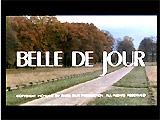
|
Belle de Jour (1967, Fr.) (aka Beauty of the Day) Luis Bunuel's carnal, unsettling, slightly perverse and groundmaking film, his first color film, was about repressed sexuality, obsession and secret fantasies - often mysteriously integrated within various segments of the film. The film was very suggestive and erotic, but not graphic, exploitative or gratuitous - without explicit nudity or sexual scenes. The main character (the "Belle De Jour" - "beauty of the day" or afternoon prostitute) often experienced hallucinated fantasies or wish-fulfillments (of S&M bondage and domination) in her unstable mind:
In the opening sequence, she experienced one of her most imaginative and recurring daydreams (of gang-rape, degradation, and masochism - whippings and bondage, and eroticism). With the off-screen dreamy sounds of her turn-ons (meowing of cats and the jingling of carriage bells - clues that she is fantasizing), she was driven in an open carriage (landau) through the woods of an estate where her husband ordered her dragged from the coach, and instructed the coachmen to gag her and tie her hands/arms to a nearby tree above her. There, he pulled down her mouth gag and threatened: "If you scream, I'll kill you." The back of her dress (and bra) were torn off and her bare back was whipped (pleasurably) by two coachmen, as she screamed out: "I beg of you, don't let the cats loose!"
Afterwards, Pierre also told one of the whipping coachman (Michel Charrel) before a presumed scene of rape: "That's enough. She's all yours ...Go ahead" --- the scene abruptly cut back to Severine's bedroom where she was lying in bed and her PJ'd husband Pierre (of one year) was in the bathroom, reflected in a mirror, who asked: "Severine, what are you thinking about? Tell me"; she answered: "About you, about us" - and mentioned that she had the coach fantasy again - theirs was an unconsummated, chaste and frigid relationship - the reason she engaged in elaborate S&M fantasies. They kissed before retiring in separate single beds, and did not consummate their love. There were a few brief flashbacks to Severine's early life as a young girl (to partly explain her mental state), when she was groped by a blue-collar worker, and she rejected a Communion wafer during a Catholic (guilt-inducing) service. Vivid sexual imaginings led her to hire herself out to brothel Madame Anais (Genevieve Page), who told her: "My girls have to be polite and very cheerful. You have to enjoy your work." Enjoying part-time suburban prostitution during afternoons only, she took the "very simple and very cute" name - 'Belle de Jour' - "easy to remember." She soon experienced a variety of strange clients - some of whom enjoyed role-playing. In one fantasy S&M sequence, Severine wearing an immaculate white gown, was tied up in a barnyard setting while Pierre and older family friend Henri Husson (Michel Piccoli) pelted her with thick black mud (or cow dung?) and called her horrific names: "Little Slut," "Bitch," "Old Whore," "Maggot," "Pig," "Scum," "Garbage," "Tramp," and "Slut." Just before the mud-slinging, Husson had pointed out his two prized bulls: Remorse and Expiation. In another scene, after she had serviced a strange East Asian client (Iska Khan) with a mysterious buzzing box, Severine's fearful but sympathetic brothel maid Pallas (Marguerite Muni) said that she had been frightened: ("That man would frighten me, too. It must be painful sometimes"); as she partially sat up on the bed, Severine replied: "How would you know, Pallas?"
In the film's most graphic set-piece, while seated alone at an outdoor cafe table, a 19th century costumed Duke-nobleman (Georges Marchal) approached Severine from a horse-drawn carriage, and brought her to his manor-chateau in the woods. As part of the debased Duke's sexual fetish, she was required to impersonate his dead daughter: ("Worms are eating you up. And the smell of dead flowers fills the room"), by lying in a coffin wearing a transparent black nightgown over her nude body, while he placed lilies on her chest and masturbated nearby. They were interrupted by the butler who asked: "Shall I bring in the cats?" The perturbed duke shouted back: "To Hell with you and your cats!" Afterwards, she was dismissed into the rain outdoors. In another carriage-woods masochistic fantasy, Severine was bound to a tree and shot in the left temple (after an imagined duel between Husson and Pierre). Pierre approached and kissed her. As the film was concluding, she found Pierre comatose in a wheelchair after being shot three times by a menacing gangster named Marcel (Pierre Clémenti) - one of her jealous and possessive admirers. But suddenly he sat up, and asked: "What are you thinking about?" (she answered: "About you"). He arose from his wheelchair, walked to the other side of the room, and poured himself a drink - the ubiquitous off-screen sounds of meowing cats and jingling bells were heard. When he suggested going to the mountains with her, she asked if he heard the bells and went to the window, where she watched from the balcony as the carriage (with two coachmen) approached - as the film ended. The carnal film ended ambiguously and tragically (was the puzzling conclusion another daydream, or was it reality - or a combination of both??) when her escapades as a part-time prostitute in a chic brothel brought sexual fulfillment (she told her husband, "Every day I love you more") - but also imagined physical (and emotional) harm to her husband. |
   Sévérine Serizy (Catherine Deneuve) with Husband Pierre 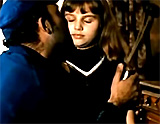 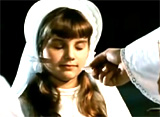 Flashback: Severine As a Young Girl - Touched Inappropriately  Severine with Brothel Madame Anais (Genevieve Page)   Brothel Clients  Fantasy: Pelted with Mud  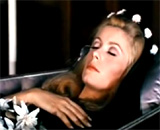 Sévérine Impersonating A Man's Dead Daughter  Fantasy: Severine Bound to a Tree |
|||||||||||||||
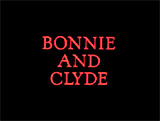
|
Bonnie and Clyde (1967) Arthur Penn's definitive film of the sixties Bonnie and Clyde (1967) was one of the most talked-about, volatile, and controversial crime/gangster films of all-time, combining comedy, terror, love, and ferocious violence. It romanticized violence in its tale of an infamous criminal couple who proclaimed:
Both tragic outlaw figures exemplified 'innocents on the run' who clung to each other and tried to function as a family. The film opened with a colorful closeup of red, luscious lips (that were being licked after lipstick had been applied). The immense lips belonged to blonde Bonnie Parker (Faye Dunaway) - a bored, beautiful, and sexually-frustrated, Depression-era Texas cafe waitress who was naked and narcissistically primping in front of a mirror. Her teasing and nude appearance at her bedroom window occurred as Clyde Barrow (Warren Beatty) eyed her Mama's car out front. She quickly dressed and descended the stairs to join him. One of the film's lobby posters described their first auspicious meeting: "They met in 1930. She was stark naked, yelling at him out the window while he tried to steal her mother's car. In a matter of minutes they robbed a store, fired a few shots, and then stole somebody else's car. At that point, they had not yet been introduced."
This film illustrated the sexy interplay between the two. Soon after, Clyde showed off his gun and bounced a wooden matchstick between his teeth (shot at an upward angle as a trembling phallic symbol), although he was later revealed to be impotent. The film's overall impact was heightened by its open examination of the gallant Clyde's sexuality-impotence and the link to his gun-toting violence. To fulfill heartthrob Warren Beatty's image as a sex-symbol, he was finally able to consummate his love for Bonnie by film's end, although it was dubiously historical. Afterwards, Bonnie assured Clyde: "You did just perfect," after which he complimented himself while chuckling: "I did, didn't I? I mean, I really did. I never figured on that. Damn." In the next bedroom scene, they discussed their relationship, although they were soon doomed to die:
|
   Bonnie Parker's Sexy Introduction   Bonnie (Faye Dunaway) and Clyde (Warren Beatty) |
|||||||||||||||
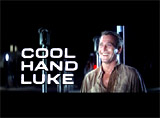
|
Cool Hand Luke (1967) Director Stuart Rosenberg's moving character study Cool Hand Luke (1967) told of a non-conformist, anti-hero loner, "Cool Hand" Luke (Paul Newman) who bullheadedly resisted authority and the Establishment. The film's theme was about the outsider-protagonist who transformed the occupants of a Southern chain gang institution and tragically sacrificed himself at the end. This chain-gang prison film contained the titillating scene of the prisoners digging a ditch by the roadside in the scorching hot sun -- when a blonde-haired, shapely, well-endowed and sexy young woman (Joy Harmon) in a nearby house prepared to wash her car. Her provocative activity sent the men into a voyeuristic, frustrated frenzy. She brought out a radio and turned it on, signaling the beginning of her sexual act. As she opened up the nozzle on her watering hose, a particularly-apt phallic symbol, the men perked up and attentively spied "the scenery." One of the prisoners couldn't endure the lustful suffering she was creating: "Oh man, oh man, I'm dyin'." She proceeded to wet down the car and then lathered and caressed white, frothy soap suds over the car's surfaces. She tempted and stimulated the men even further in the symbolic simulation of the sex act. She looked into the car's rear view mirror and into one of the tire's shiny hubcaps to look back to see how the men were being pleasured. Her loose-fitting blouse with well-endowed breasts began to open up and taunt them. Gambler (Wayne Rogers) observed:
The men dug more vigorously as she heightened her own cleansing activity. Dragline (George Kennedy) prayed to the heavens to sustain his eyesight just a little longer for the girl he named Lucille:
Knowing that she had a ripe and attentive audience, the blonde rubbed the car harder and harder. In the most blatantly sexual act of all - the orgasmic conclusion to her show - she squeezed the white foam out of her sponge and rubbed the soap suds across her abdomen. Luke knew what she was doing: "She knows exactly what she's doin'. She's drivin' us crazy and lovin' every minute of it." She gently drank from the end of the penis-shaped hose and then while washing the roof of the car, her soaped-up, ample breasts were squeezed as they rubbed back and forth across the car's window. |
      Sexy Young Woman (Joy Harmon) - Sudsing Up the Car as a Sexual Act |
|||||||||||||||

|
The Fearless Vampire Killers (1967) (aka Dance of the Vampires or Pardon Me... But Your Teeth Are in My Neck) Director Roman Polanski's Gothic vampire horror spoof was about two vampire hunters who attempted to destroy an undead count, while rescuing a beautiful maiden in a Transylvanian town in the mid-1800s:
The young, innocent and buxom innkeeper's (Alfie Bass) daughter Sarah Shagal (Sharon Tate, director Polanski's soon-to-be-wife in her debut feature film appearance), who loved to take baths, bathed twice in a tub in the most sensual scenes of the film. In the first bathing sequence set in the local village's tavern, vampire Count Von Krolock (Ferdy Mayne) descended through the ceiling, and flared his fangs at her before biting her. She flailed around in the tub as her neck was bitten, and her mouth was covered (to prevent screaming). In the second sequence, the kidnapped Sarah was oblivious to danger when Alfred attempted to save and warn her by following after him: ("l'm going to save you. We'll go away together"), but all she wanted to do was attend the midnight (vampire) ball and wear her beautiful red dress. Heavily publicized, semi-nude shots of Sharon Tate were not in the film, but in promotional materials including a March 1967 Playboy pictorial shot by Polanski himself.
|
 Sarah Looking Up as the Count Entered the Room 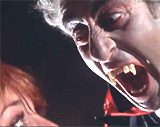 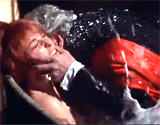 First Bathing Sequence in Film 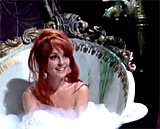  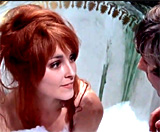 Second Bathing Sequence |
|||||||||||||||

|
The Fox (1967, Can.) Director Mark Rydell's first feature film was a stark adaptation of D. H. Lawrence's 1923 novella of lesbian love. The candid and controversial drama was originally rated R in 1968 (for its scene of nude masturbation and mild scenes of sexuality, lesbian and heterosexual), but then was re-edited and rated PG in 1973. It examined the lives of two female lovers on an isolated, snowbound farmhouse (a self-sustaining chicken farm) in Canada, who shared the same bed in a sublimated lesbian relationship:
The arrival of a third person - self-confident merchant seaman Paul Renfield (Keir Dullea) - symbolically and metaphorically, the predatory 'male' fox (who challenged the coop and killed the real-live fox), disrupted and changed the relationship between the two women within the tense love triangle. There were tasteful and discrete scenes of sexuality:
In one telling scene after his arrival, Paul asked Jill why she had never married:
By film's end, the bisexual character of Ellen, who originally decided not to abandon Jill for Paul, chose to start a new life with Paul after Jill was killed by a falling tree. Jill had stubbornly refused to heed Paul's warning and move out of the tree's possible path when it was about to be chopped down by Paul.
|
  Ellen (Anne Heywood) with Jill (Sandy Dennis)  Paul with Ellen   The Death of Jill |
|||||||||||||||
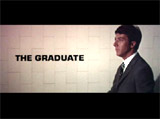
|
The Graduate (1967) Mike Nichol's award-winning, milestone film of the 1960s The Graduate (1967) was a bold social satire film combining adultery, nudity, and anti-establishment subject matter. It featured an average-looking newcomer named Dustin Hoffman in the lead role as young graduate Ben Braddock who would experience an illicit and sexy seduction (and awakening) by older, provocative and predatory married female - Mrs. Robinson (Anne Bancroft) - the frustrated wife of his father's law partner. She quizzically asked him: "You want me to seduce you, is that what you're trying to tell me, Benjamin?" (with his befuddled reply-question: "Mrs. Robinson, you're trying to seduce me? Aren't you?"). She assaulted him in her own home by exposing her breasts to him (seen in split-second, jump-cut flashes but first reflected in the picture of her daughter Elaine (Katharine Ross)) in her bedroom, and by blocking his exit.
At the same time that he entered into an affair with her, Benjamin dated the more appropriately-aged Elaine. On their first date, he deliberately tried to put Elaine off by being offensive. Without communicating with her (wearing his sunglasses at night), he drove recklessly in his sports car and then marched ahead of her into a tawdry strip joint to humiliate her. The stripper (Lainie Miller) twirled the dangling tassels on her bare, rotating breasts directly behind Elaine's head, while Ben asked:
He removed his sunglasses [his barrier] as he saw tears forming in her eyes, and stopped the tawdry show. Disgusted and humiliated in shame, Elaine ran out. In the climactic concluding scene, Benjamin interrupted her marriage at a church and took her away on a city bus to an uncertain future. |
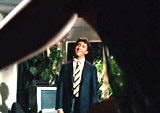    Benjamin (Dustin Hoffman) with Mrs. Robinson (Anne Bancroft)  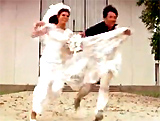  Benjamin's Rescue of Elaine From Marriage |
|||||||||||||||

|
Guess Who's Coming to Dinner (1967) Stanley Kramer's and Columbia Pictures' socially-conscious message film explored the touchy issue of inter-racial romance. This progressive film (though dated now) was the first truly mainstream Hollywood film to portray an interracial couple's romance that turned out optimistically. The mixed couple were:
Except for one brief revolutionary view of the couple kissing (seen in a cab driver's rear view mirror on their way to the city of San Francisco from the airport), other scenes of their physical intimacy were edited out. |
 Rear-View Mirror Inter-racial Kiss |
|||||||||||||||

|
A Guide for the Married Man (1967) Based upon Frank Tarloff's book of the same name, this dated, misogynistic, humorless sex comedy (directed by Gene Kelly!) was of the opinion that sex and infidelity could freely be discussed, without being very visually explicit. The film's tagline explained:
In the film's trailer, the narrator promised to give viewers some "pointers," accompanied by suggestive images:
This foul, light-hearted sex film was typical of a number of films of the 'sexual revolution' of the late 60s, with little in the way of nudity due to Production Code restrictions still residually in force, but with lots of leering views of stacked and teasing bombshells clothed with hip-swinging, tight outfits. The picture's gimmick was that it featured many notable cameos from Art Carney (with Lucille Ball), Jack Benny, Louis Nye, Phil Silvers, Joey Bishop, Sid Caesar (with Karen Arthur), Wally Cox (with Maureen Gaffney), Terry-Thomas (with Jayne Mansfield), Carl Reiner (with Linda Harrison as Miss Stardust), and Polly Bergen. It preached the philosophy that cheating and adultery could be taught to any husband. Bored business investment counselor Paul Manning (Walter Matthau) had been married for twelve years to Ruth (sexy and gorgeous Inger Stevens), who was undeniably gorgeous and sexy. In their bedroom, she performed breast-enhancement exercises, stripped off her leotard, and attempted to entice her disinterested husband into noticing her with a see-through nightgown. Ruth's husband Paul was taught how to wife-cheat by self-proclaimed, expert philanderer - his friend and neighbor Ed Stander (Robert Morse) who was married to Harriet (Claire Kelly) and cheating on her. Paul was instructed in a series of vignettes about the "do's and don'ts" of successful and failed affairs. Part of the reason for Paul's roving eye was due to his interest in his shapely and provocative married neighbor Irma Johnson (Sue Ann Langdon).
In one of the lessons (scenarios) on how not to get caught, Charlie (Joey Bishop) was found by his enraged wife (Ann Morgan Guilbert) in bed with a naked woman. When confronted ("What are you doing?") with lots of questions, he calmly denied all of the charges she asked of him, while they both dressed:
He wasn't even ashamed of himself, and when she had accepted his story, she asked: "What would you like for dinner?" The final resolution of the film came with Paul ready to cheat with his first target - the strikingly-pretty, rich brunette divorcee Jocelyn Montgomery (Elaine Devry) who was with him in a room of the Happy Hour Motel, wearing only a sexy black bustier. At first he was reticent, and showed her snapshots of Ruth and his family. He had further second thoughts when he heard a commotion and photographers across the way, and was fearful of getting caught. He fled the room with her and quickly returned to his beloved wife. Then he found out that the authorities had arrested Ed with Mrs. Irma Johnson - who ended up with a divorce. |
  Ruth (Inger Stevens) 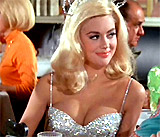 Miss Stardust (Linda Harrison)  Harriet Stander (Claire Kelly) |
|||||||||||||||
 
|
Sweden's landmark, avante-garde, mock-documentary film (shot with mostly hand-held cameras) allegedly included 'offensive' sexual scenes that challenged existing boundaries. US Customs seized the film in 1968, and the courts (and the Supreme Court) originally determined that the movie was 'obscene.' It was subsequently banned for its pornographic content, although this verdict was eventually overturned after appeal. Many Supreme Court battles ensued before it could be distributed. It became a benchmark film for free-speech advocates. After it was cleared and released in the US in 1969, it became a blockbuster hit, although it was often picketed. It garnered $5 million in six months (a much higher figure when adjusted for inflation). The Swedish import soon became the highest-grossing foreign film (at $20 million) released in the US for decades (a record that stood until Il Postino broke the mark in the mid 1990's), although most who watched it considered it boring and pretentious.
But by today's standards, I Am Curious (Yellow) has to be considered tame, but at that time, it helped to open the floodgates toward more explicit films, such as the X-rated Best Picture Midnight Cowboy (1969) and Bernardo Bertolucci's Last Tango in Paris (1972), and more hard-core pornography (with oral sex, penetration, and ejaculaton) exhibited in the porno chic Deep Throat (1972). The radical, experimental film-within-a-film of sexual politics told the dull and pretentious story of liberated, plumpish 22 year-old Lena (Lena Nyman), an aspiring sociologist who was investigating Swedish social and political conventions. She was curious about political issues in late 60s Sweden, with endless soul-searching, lengthy street interviews with common people about the class system, newsreel footage, scenes of protest regarding the Vietnam War, scribbled on-screen slogans, her cataloguing of information, etc.
Sexual interludes also pushed the boundaries of love-making between Lena and car salesman Borje Ahlstedt (Borje Ahlstedt) (mirrored in the film and real life by a tumultuous triangle with director Vilgot Sjoman). The scenes were shot frankly and realistically. There were scenes of full frontal nudity of both sexes (at 38 minutes into the film), simulated rear-entry intercourse, and the kissing of the male's flaccid penis (over a full hour into the film) and stroking of pubic hair. |
 Lena (Lena Nyman)  Borje (Borje Ahlstedt)    Additional Sexual Scenes |
|||||||||||||||

|
Valley of the Dolls (1967) This successful Fox film from director Mark Robson was based upon Jacqueline Susann's top-selling novel of 1966. It became Fox Studios' top money-maker hit for 1968, although it was severely criticized by most film critics as vulgar and sensationalistic. Most of the sex (filmed in silhouette), scandal, and drug abuse now seems tame by today's standards. The campy classic included scenes of the three major stars' many sexual dalliances (never very explicit) and tragic failings due to pill-popping (pills=dolls), drinking and addiction. During the prologue during the opening title credits, one of the three "dolls" (Anne Welles) spoke the film's first dialogue (in voice-over) as an animation played of three characters transformed into colorful "dolls" or pills:
It was a trashy, kitschy, and 'it's-so-bad-it's-good' soap-opera about three aspiring starlets who found popularity and fame, but all of them soon became 'corrupted' by show business in both New York and Hollywood:
In the opening sequences, the three main characters were introduced as their paths began to repeatedly crisscross throughout the film. The naive, Radcliffe-educated Anne Welles (Barbara Parkins) had arrived in NYC from her hometown of Lawrenceville in New England and found employment as a secretary with a theatrical law firm and talent agency - Bellamy and Bellows. In a local Broadway theatre during a rehearsal where she was delivering contracts to aging, vulgar, selfish, egotistical and abrasive actress Helen Lawson (Susan Hayward), Anne was shocked when in Helen's dressing room, she saw the marked difference between Lawson's glamorous public image as a musical comedy star-diva and her mean-spirited and real-self (an "evil queen bitch") in the "cruel business" of entertainment. She listened as the determined Helen felt threatened and vowed to fire an aspiring and talented young actress-singer named Neely O'Hara (Patty Duke), for fear of being upstaged:
Neely decided to leave the show when Helen threatened to cut her only number: ("I won't settle for crumbs. I'll leave this stinking show - with dignity"). Her devoted, press-agent boyfriend Mel Anderson (Martin Milner) comforted Neely with a hug:
A third performer in the show was a pretty but untalented showgirl named Jennifer North (Sharon Tate), who remained a friend to Neely and soon became friends with Anne too. While struggling to find work, Neely was living with Mel in a cheap NYC apartment. Lyon helped Neely to find work with an appearance on a popular telethon to support cystic fibrosis, and as a singer in a nightclub. When Neely's own popularity and singing career began to improve, she and Mel made plans to marry: ("Mel, let's get married...I'm not kidding. I'll be making good money. And with your 150 a week, we can really live"). Meanwhile, the third "doll" Jennifer had begun secretly dating another nightclub singer Tony Polar (Tony Scotti), although Tony's controlling half-sister Miriam (Lee Grant) disapproved of their relationship ("But Miriam's got this thing about marriage. She thinks it'll destroy what she calls my image").
The talentless Jennifer regularly performed bust exercises, and was financially supporting her mother who often called on the phone. During one conversation, Jennifer admitted: "Mother, I know I don't have any talent, and I know all I have is a body, and I am doing my bust exercises." After the call, she was ready to give up: "Oh, to hell with them! Let 'em droop!" Anne soon found romance with her agency's younger business partner, handsome attorney Lyon Burke (Paul Burke), although the womanizer was opposed to getting married: ("I'm not looking for a wife. No, some men just don't pull well in double harness"). Neely's growing stardom brought her fame on Broadway, prompting Lyon to send her (and Tony) to Hollywood for singing auditions. Neely received acclaim at the Grammy's and was soon making films for a Hollywood studio. Simultaneously, Jennifer suddenly married Tony, causing concern for Miriam as the newlyweds also relocated to the West Coast, where Jennifer's modeling career blossomed and Tony's singing (and cross-over to acting) career had also taken occurred. Ultimately, Anne and Lyon broke up over their differences, and Anne was hired away from the law firm to take a cosmetics company modeling job, where she would soon become known as "The Gillian Girl." Over time, her popularity soared and she became a familiar face on TV commercials, billboards, and in other magazine/newspaper ads. She had a brief fling with her promoter - Kevin Gillmore (Charles Drake). In Hollywood, Jennifer spoke to Mel about finding more acting work for her husband Tony. Worried, Mel told Jennifer about major changes in Neely's personality, due to the corruptive effects of show-business. Her life now consisted of a busy work schedule, including wardrobe fittings, makeup tests, publicity stills, plus increasingly-close interactions with effeminate and wealthy Hollywood designer Ted Casablanca (Alexander Davion), and the use of amphetamines and downers: "She starts at 5:30 in the morning, still punchy from last night's sleeping pills. So she takes a red pill to pep herself up and at midnight she's still flying. I try to talk to her, it's like a brick wall....The studio wants her to find out why she's so exhausted. They say they think it must be emotional conflicts. Conflicts, my foot! There aren't enough hours in the day. The head shrinker says she's - insecure. She needs mass love." There were obvious cracks in their relationship due to Neely's suspected affair with her designer Ted Casablanca, and Neely's accusations that Mel was living off her earnings:
Neely appeared to be cheating on Mel in an affair with her designer Ted Casablanca - and her abuse of drugs, promiscuity, and unpredictable behavior further doomed her relationship with Mel. They ultimately separated and then divorced.
While Neely and Mel were splitting up, and she began dating Ted, Anne - after her successful career had been launched - was able to rekindle her relationship with Lyon (who remained Neely's agent) in Los Angeles. There were further signs that Tony had a severe, genetically-inherited terminal illness known as Huntington's Chorea (a debilitating motor-neuron disease), and his condition would affect any children that he fathered: ("Chances for inheritance are extremely high, far above average"). When Jennifer found out, she was devastated with the news since she was pregnant at the time - and she began to seek an abortion. Jennifer's debilitated husband Tony was dying of an incurable disease and was taken for treatment at Longview Sanitarium. Miriam contacted Frenchman Mr. Claude Chardot (Richard Angarola) - a "quickie European movie producer" to help pay Tony's bills by having Jennifer negotiate to make "raw," artsy soft-core 'nudie' films in Europe. He was interested in hiring an American because, as he put it: "The general French girl is inclined to be flat in the bosom." In the meantime while Jennifer was in Paris, Neely married Ted, but the price of fame and stardom was taking its toll on the "self-destructive" and self-loathing Neely from her increased drug abuse and alcoholism. She was cautioned by Anne one evening to not consume both together:
And then later that evening, wearing only her bra and panties, Neely caught her husband Ted cheating on her by skinny-dipping with a young female in their pool. She screamed out:
The next day, Neely's agent Lyon reprimanded Neely still asleep in her bedroom for her tardiness, drug and alcohol abuse, and informed the 26 year-old that she had been fired from the studio: "They're replacing you in the picture....You've been out six days because of sleeping pills. You've been late on the set, and you walked out in the middle of the day. To top it all, you've been boozing and eating all through the picture!" The down and out (and completely strung out) Neely agreed to dry out at an LA sanitarium, but then impulsively flew to San Francisco. There outside of a number of topless bars and adult theaters (where Jennifer's 'cutie nudie' picture "The Flame of Montmartre" was showing at the Lyric) were playing, she exclaimed - in the film's most quoted lines:
Upon her return to LA, Neely was hospitalized in the same sanitarium where Tony had been hospitalized. Finally back on the West Coast from Europe and temporarily housed in the Bel Air Carlton Hotel, Jennifer was doubly devastated, both by Tony's condition and by a biopsy of her breast lump that discovered she had a malignant tumor in her left breast. She was scheduled for a mastectomy the next day. She confided in Anne that all she had was a pretty face and body: "All I've ever had was a body, and now I won't even have that....Anne, honey, let's face it. All I know how to do is take off my clothes." On the phone, she also told her mother: "I won't be undressing in public anymore." Rather than having a disfiguring surgery that she thought would ruin her film career (and make her unable to pay Tony's bills), she took a lethal drug overdose. Her final thoughts and memories were of Tony. After recovering to some degree at the sanitarium, Neely made plans to join her agent Lyon in NYC for a planned stage comeback in a new Broadway show. Hints that they were having an affair reached Anne - and she was crushed with the news. It caused Anne to begin indulging in pill-popping - symbolized by a close-up of her new prescription.. Although uninvited, Neely stormed into a press reception party for her former nemesis Helen Lawson whose new play was about to open. Confronting each other, they engaged in a wild hair-pulling cat fight in a fancy ladies' room. The argument began when Helen criticized Neely's lack of talent and promise due to drug abuse:
Neely retorted: "That's a switch from the fags you're usually stuck with." Helen replied: "At least I never had to MARRY one!" Neely angrily shouted: "YOU TAKE THAT BACK!" as she pulled off Helen's wig and insulted her after noticing her gray hair: "Oh, my God. It's a wig!...HER HAIR'S AS PHONY AS SHE IS!" Neely gave the wig a "shampoo" by dropping it into a toilet bowl ("Giving it a shampoo. Goodbye, pussycat. Meeowwww!") but it wouldn't flush away. She tossed the wet wig back at Helen: ("Here it comes, special delivery"). Afterwards, she spoke to Lyon with words of advice: "I've had it rough before. I'm a barracuda. I don't need pills like Neely. Sure, I know you dried her out, but it won't last. Neely hasn't got that hard core like me. She never learned to roll with the punches. And believe me, in this business, they come left, right and below the belt...Nothing can destroy her talent. But she'll destroy herself....watch it, my friend. Find yourself a good girl, have kids, or one day you'll wind up alone like me and wonder what the hell happened." The news of Jennifer's suicide (in addition to her loss of Lyon to Neely and her beginning dependence on pills) was so upsetting to Anne that she abandoned everything to return back to her idyllic New England hometown. Neely also self-destructed by needlessly breaking up with Lyon just before her opening night at The Playhouse Theatre in "Tell Me, Darling." After boasting to him: "I licked pills, booze and the funny farm. I don't need anybody or anything," she fired him: "Who needs you? You're just an agent!" Then, wearing her 2nd act costume, she appeared so disoriented and drunk for her stage entrance that she had to be replaced by her understudy. That night, she ended up in a bar drinking and ingesting pills - and then down-and-out as a burned-out addict in a deserted alleyway, all alone and calling out to all her discarded friends: "Where is everybody? Hey, everybody, where are you?" as a bell tolled. In the film's ending, Lyon attempted to reconcile himself with Anne by visiting her in her hometown, but she decided to politely decline his proposal of marriage: ("It wouldn't work, Lyon...Perhaps someday, Lyon. I don't know"), choosing instead to be independent and single. Anne attempted to start fresh by walking away by herself down a snowy road. |
 Anne's (Barbara Parkins) Arrival in NYC from Her New England Hometown  Helen Lawson (Susan Hayward)  NYC Press Agent Mel Anderson (Martin Milner)  Neely (Patty Duke) - Deciding to Leave the Broadway Show  Lyon with Anne  Mel with Neely 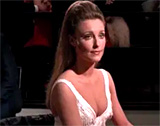 Jennifer Listening and Becoming Infatuated With Lounge Singer Tony  Jennifer's Bust-Firming Exercises  Anne as the New "Gillian Girl"  Neely's Divorce From Mel - And Affair/Marriage to Ted Casablanca  Neely - Consuming "Dolls" with Alcohol     The Pool Confrontation Between Neely and Cheating Husband Ted (Alexander Davion)   Neely Fired From the Studio and Reprimanded by Her Agent Lyon   Jennifer Advertised as Appearing in European 'Nudie' Flicks  Neely: "Boobies, boobies, boobies. Nothin' but boobies"  Neely in LA Sanitarium  Jennifer (Sharon Tate) - After Being Tested for Breast Cancer  Jennifer's Suicidal Drug Overdose  Anne's First Use of Prescription Drugs  
Helen and Neely's Confrontational Cat-Fight  Helen's Spiteful Words About Neely to Lyon  Neely Breaking Up with Her Agent Lyon  Neely Drunk and Disoriented Before Her Theatre Opening  Neely Drunk and Addicted In An Alleyway After Her Disastrous Opening Night |
|||||||||||||||

|
Weekend (1967, Fr) Writer/director Jean Luc-Godard's prescient, nihilistic and politicized black comedy was a critique of the bored and selfish bourgeoisie. It was an allegory about the breakdown of society and the collapse of civilization. Its title derived from the time-frame of the film involving an upper-class, bickering murderous Parisian couple on a weekend trip to the countryside. The outrageous film was controversial for displaying many taboos, including patricide, rape, immolation, animal cruelty, and cannibalism. The main detestable, bickering characters on an outdoor Parisian apartment balcony were two members of the bourgeoisie:
Both had contempt for each other - the two venal marrieds both had other lovers and were secretly plotting to murder each other. More importantly, the couple was about to take a weekend car trip to the home of Corinne's parents in Oinville, in order to visit her dying father and ensure the acquisition of inheritance money from him (they had been slowly poisoning his food for five years). There were four main segments in the film: DESCRIPTION OF AN ORGY: She described a threesome between a couple (Paul and his wife Monique) and herself that was explicitly detailed (as the camera shifted left and right, and zoomed in and out). In a monotone voice, she hesitantly described a perverse sexual encounter or orgy involving food and sex (foreshadowing a more depraved sex act of rape in the film's finale). The three ended up in the kitchen, with instances of oral sex, masturbation, intercourse, the cracking of an egg between buttocks, and the act of sitting naked in a cat's bowl of milk. Afterwards, she was asked if the story actually happened or was just a dream-nightmare:
WEEKEND BLOCKADED ROAD: There were views of people card playing, tossing a beach ball, book-reading, engaged in a chess match, arguing, listening to a radio, sleeping, and urinating. Also, there was the sights of a traveling menagerie of caged monkeys, lions, and a llama. They passed a bus, a horse pulling an open load of manure, a gigantic red and yellow Shell Oil tank truck, and a sailboat. During the lengthy almost 8-minute long tracking shot (the longest of its kind at the time, moving in a parallel track along the roadway), they came upon more battered, wrecked burning cars, and mangled, mutilated bodies and bloody casualties at the front of the traffic jam. At the end of the long string of cars, they turned right onto a rural road. However, they came upon more surrealistic and nightmarishly apocalyptic images and examples of social unrest and catastrophe in a small town and in the countryside - more collisions and bloodied or dead people. Eventually, their own car crashed into a pile of other flaming vehicles. PIANO CONCERT AND SPEECHES:
Three political speeches or monologues were then delivered by two sandwich-chewing migrant garbage workers, Mon Frère Africain (Omar Diop) and L'Arabe (Laszlo Szabo). The discourses included talk of revolutionary violence by the oppressed to obtain liberation, and the denouncement of oppressive Western imperialism in Africa. The camera focused in the first two speeches on the non-speaking worker, and in the third speech on Corinne and Roland in the audience. After hitching a ride to Oinville, one in-joke about American prudishness showed Corinne discreetly taking a bath below an erotic painting - the breasts of the painting's female were clearly visible, but Corinne's real breasts weren't in plain view. At her parents' country place, the couple found that her father had already died, and he had left everything to the wife. She refused to split her 100% share. In a brutal outdoor terrace strangulation (by Roland) and stabbing-murder (by Corinne) sequence, Corinne's mother was carrying a flayed rabbit from the butcher shop. [Note: The knife-wielded stabbing paid homage to Hitchcock's famous Arbogast murder scene in Psycho (1960).] Her death was juxtaposed with the sickening and gruesome view of the rabbit being doused by the spilling of her blood as she screamed - followed by their criminal plot ("the perfect crime") to hide the cadaver by stashing it in a crashed vehicle (and plane) along the road and setting it on fire. TAKEN HOSTAGE:
At the group's outdoor base camp in the woods where the hostages were brought, the cook Ernest (Ernest Menzer) (with a blood-stained white gown and a large butcher knife) was told: "You can screw her before eating her, if you like." The anarchists communicated by radio with film title code names, such as: "Battleship Potemkin calling The Searchers." One of the stripped and captive female hostages, an English tourist, was sexually tortured and raped by the repulsive group of terrorists. In preparation for her as part of a cannibalistic meal, the cook ritualistically cracked two eggs onto her crotch (as a garnish) and inserted a large dead fish into her opened thighs (her vagina was regarded like a pig's mouth with an apple) instead of his own phallus. It was a nightmarish re-enactment of the film's earlier kitchen-counter sex orgy. Roland was murdered (off-camera with a slingshot) when he tried to escape, and subsequently disemboweled: ("The horror of the bourgeoisie can only be overcome by more horror"). There were also the the disturbing unsimulated sequences of the gross slaughter of a pig and a live goose. Corinne joined the leader after his girlfriend Valérie (Valérie Lagrange) was killed in a shootout. The film's last scene was Corinne feasting on meaty stew bones, created from the flesh and bones of Roland, plus the remains of other hapless hostages:
The film ended with two different title cards: "End of Story" (Fin de Conte) and "End of Cinema" (Fin de Cinéma). |
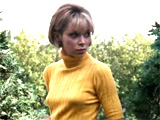 Corinne Durand (Mireille Darc)  Opening Sex Orgy Monologue: Corinne with Roland 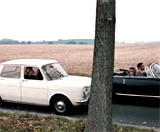 Passing All Cars on the Left  Caged Animals 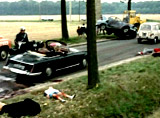 The Mammoth Traffic Jam  Casualties  Their Own Car Crash 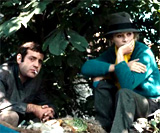 Roland and Corinne  Corinne Bathing 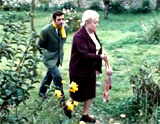 Corinne's Mother with Skinned Rabbit - Just Before Her Own Strangulation and Stabbing-Murder  Rabbit Doused by Mother's Spilled Blood 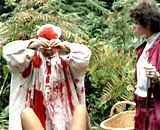 The Brutal Anarchist Rape Scene - Opened Thighs of Female Hostage  Corinne Taken Hostage  The Death of Roland 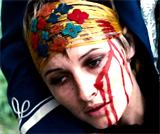 The Death of Chef's Girlfriend Valerie  Corinne's Cannibalistic Appetite for Her Own Dead Husband  Ending - Title Card |
|||||||||||||||